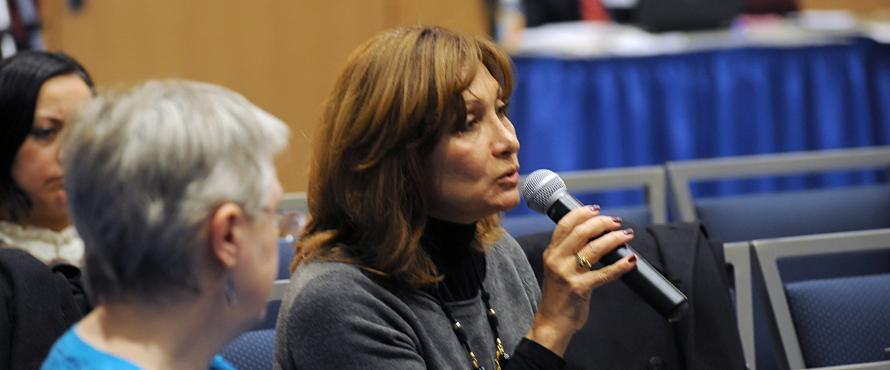Ana Gil-Garcia sure knows how to make an exit.
In the month before her Sept. 5 departure to spend the academic year teaching at Prince Mohammad bin Fahd University in Khobar, Saudi Arabia, the Northeastern Illinois University education professor learned she had won three awards:
- The Golden Apple of Western Michigan University, her alma mater, for her dedication and commitment to education
- The Women of the Year (Mujer del Ano) given by the National Hispana Leadership Institute
- The Hispanic Educator of Illinois given by the state comptroller
We contacted Gil-Garcia, a four-time Fulbright U.S. Scholar, via email just after she arrived in Saudi Arabia to ask how she’s adjusting, what she hopes to learn and to tell us a crazy classroom story that you have to read to the end to believe.
What kind of work are you doing in Saudi Arabia?
I will primarily be teaching undergraduate females on core courses that include leadership, teamwork and learning outcomes. I also will be mentoring and advising younger faculty on conducting research for presentations and publications.
Is the work relatable to anything that’s happening in Chicago?
Teaching and researching are two university functions that are universal missions of any higher education institution. Saying that, I will be working on those two university missions. That’s happening at all higher learning institutions in Chicago.
At the personal level, what is different is that I have not taught undergraduate courses for long time, I have not taught female students only, and I have not trained students on leadership development with imposed gender-related restrictions.
In Chicago—and especially at Northeastern—there is a growing population of Muslim students who behave accordingly to their roots, culture, social norms and religion. The Muslim student group has been perhaps one of the fastest-growing populations at Northeastern for long time.
What do you hope to learn from your experience there?
Saudi Arabia is not my first Middle East professional experience. As a Fulbright scholar in 2010, I spent three months in Doha (Qatar), Kuwait City (Kuwait), and Dubai, Abu Dhabi and Sarjai (United Arab Emirates). In 2011, I was invited by the American University in Cairo to teach and research at the Graduate School of Education. I arrived in Egypt during the Arab Spring, witnessing the revolution, the beginning of democratic signals, and the primary and general elections.
From those experiences, I increased my understanding of the Arab culture and society. The Arabs were in Spain for more than 800 years, and as a Hispanic/Latino, I was able to create a personal link with the Arabic language (similar words in use), social norms, body movements, skin complexion and food flavors, among other cultural similarities.
It may be a little bit different from the above experiences living here in Khobar, Saudi Arabia. Of all Arab countries, Saudi Arabia is the most traditional, restricted and closed. Women face severe discrimination for being women. For example, upon my arrival at Prince Mohammad bin Fahd University, I was ordered to wear the black abaya in the classroom and in the “green zone,” an area shared by male and female administrators. When introduced to a male administrator, I need to remember that I cannot shake hands. As a woman, I cannot go out by myself. I would be stopped and questioned by the moral police.
Although the buses that transport faculty and staff from the gated university housing compounds carry men and women, the men are dropped off at the male campus first. Women are then dropped off in the back of the female building.
I am learning that it is difficult for me to teach leadership and teamwork to female students whose lives are subjected to social traditions and cultural limitations. I am learning that my female students perceive leadership as a male-related subject because it involves empowerment, creating change and acting decisively. In this culture, some of those leadership factors are connected with masculinity. How to shift that paradigm?
I am learning different things every day. I am affected by the internationalization efforts of the university to recruit all over the world. The Department of Core Curriculum has 16 female faculty, and 14 are from overseas.
Where else would you like to teach?
I would like to end my teaching career somewhere in a Spanish-speaking country, especially in an underdeveloped country such as El Salvador, Honduras, Bolivia or Paraguay. There is still a lot to do in “the back of the yard” of the United States: Central and South America. I am a true believer that education is liberation and emancipation. For that reason, if the educational systems in those regions improve, the immigration would be controlled.
When you teach internationally, what do you do in your free time?
Wherever I go, I contact my fellow Fulbrighters living in the city or visiting the city as scholars. It has become my “international practice” to check with the U.S. Embassy whether or not there is a Fulbright Alumni Association. If so, I make a call and introduce myself. Due to the sense of family Fulbrighters share, my weekends quickly are filled with activities in and out of the city! I love traveling to rural areas to meet people, taste their local food and enjoy the differences.
And let’s end with a silly question: What is the craziest thing you’ve ever seen a student do in one of your classes?
When I was in Armenia, I had an undergraduate student take my graduate class for the entire semester only to realize at the end that she was in the wrong course!








